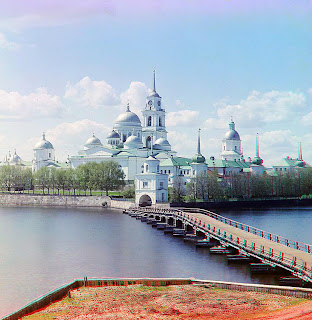Sergey Mikhaylovich Prokudin-Gorsky (1863-1944) was a true pioneer of color photography. He created his own methods to capture life of the early 1900 -in color- using three filters and a tedious sequential exposure method.
"His process used a camera that took a series of three monochrome pictures in sequence, each through a different-colored filter. By projecting all three monochrome pictures using correctly colored light, it was possible to reconstruct the original color scene. Any stray movement within the camera's field of view showed up in the prints as multiple "ghosted" images, since the red, green and blue images were taken of the subject at slightly different times." [Wikipedia]
"Outfitted with a specially equipped railroad-car darkroom provided by Tsar Nicholas II and in possession of two permits that granted him access to restricted areas and cooperation from the empire's bureaucracy, Prokudin-Gorsky documented the Russian Empire around 1909 through 1915. He conducted many illustrated lectures of his work. His photographs offer a vivid portrait of a lost world—the Russian Empire on the eve of World War I and the coming Russian Revolution. His subjects ranged from the medieval churches and monasteries of old Russia, to the railroads and factories of an emerging industrial power, to the daily life and work of Russia's diverse population." [Wikipedia]
"His process used a camera that took a series of three monochrome pictures in sequence, each through a different-colored filter. By projecting all three monochrome pictures using correctly colored light, it was possible to reconstruct the original color scene. Any stray movement within the camera's field of view showed up in the prints as multiple "ghosted" images, since the red, green and blue images were taken of the subject at slightly different times." [Wikipedia]
"Outfitted with a specially equipped railroad-car darkroom provided by Tsar Nicholas II and in possession of two permits that granted him access to restricted areas and cooperation from the empire's bureaucracy, Prokudin-Gorsky documented the Russian Empire around 1909 through 1915. He conducted many illustrated lectures of his work. His photographs offer a vivid portrait of a lost world—the Russian Empire on the eve of World War I and the coming Russian Revolution. His subjects ranged from the medieval churches and monasteries of old Russia, to the railroads and factories of an emerging industrial power, to the daily life and work of Russia's diverse population." [Wikipedia]








No comments:
Post a Comment